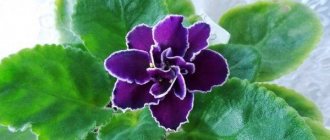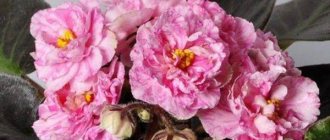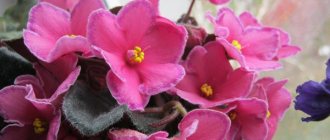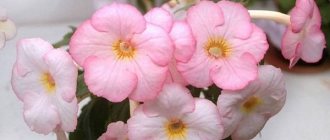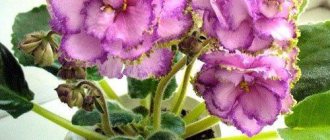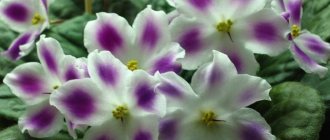Acquisition
By the way, about what else to call these flowers when searching and buying: this name for domestic violets is less familiar to us, but our same native domestic violets are still called Saintpaulia or Usambara violets.
So, the first thing a florist who plans to buy violets needs to know: these flowers are conventionally divided into industrial and varietal. Industrial violets (those that were grown in greenhouses on an industrial scale and do not have a variety of varieties) can be bought in a regular store like Leroy Merlin, OBI, etc., and varietal violets can be bought from private breeders, at specialized exhibitions, or simply from familiar flower growers. What's better?
- Experienced violet growers do not recommend buying flowers in regular stores, since often after flowering they do not take root and die. If you are a beginner, then it is safer to buy both “industrial” and varietal violets from private individuals.
Here are some tips for purchasing varietal violets:
- Having bought a violet, be sure to save the name of the variety, otherwise it will be difficult to restore it - there are too many similar hybrids. By the way, more than 25 thousand varieties of Saintpaulia are registered in the world. All of them are derived hybrids of “wild” violets and have a common name - Saintpaulia hybrida. As a rule, each flower is signed in the format: name of the breeder-creator of the variety - name of the variety.
- If you want to save a lot, buy leaves rather than mature flowers. After all, growing a violet from a leaf is very easy and the result is almost always successful.
- You can find and buy the flowers of your dreams through Instagram. Type in the search the hashtag #varietal violets and you will see many photos of violets with the names of the varieties and contacts of breeders who send plants and leaves for propagation throughout the country.
However, with proper care and a bit of luck, even discounted and diseased industrial violets (see photo below), or as violet growers lovingly call them, “soakers,” have a great chance of life.
Publication from Love. Collection of violets (@fialki_26) Sep 16, 2017 at 12:36 PDT
How to choose a violet in a store?
The abundant bloom of homemade violets in the store may distract you from the leaves, but their condition can help assess the health of the flower. Spots and dried edges are a bad sign, fleshy green leaves are a good sign. A violet with dense buds and the first opened flowers is suitable for us: it is their color and shape that you should fall in love without words, otherwise why did we start all this!
Flower propagation
Planting seeds
Violets can be propagated by seeds. Before sowing, they are treated with a solution of “Zircon ” or “Epin” . At the end of spring, the seeds are sown in warm, fertile soil, where the groundwater lies quite deep. The ideal option for the soil is a mixture of loamy soil with humus . You can mix humus equally with peat and add sand.
The seeds should be scattered into the grooves (50 seeds per meter is enough). Experienced gardeners sow 3-4 seeds per hole, at a distance of 60 cm . The seeds are buried 6 mm, sprinkled with a little soil and watered. To prevent the soil from drying out, the planting site must be sprinkled with a layer of sawdust. Viola will begin to bloom in early June. Weak shoots must be shaded from the bright sun for at least the first 10 days.
Viola seeds of different types that can be bought at a flower shop
Seeds of two-year-old violets should be sown in midsummer and cared for using the same technology. It should be planted in a permanent place at the end of summer, and covered with spruce branches for the winter. Violets will bloom next summer.
Germinating viola seeds before planting in open ground
Seedlings
Seeds are sown in containers with fertile soil. The temperature should be about 25 degrees . When the seedlings sprout, the temperature can be reduced to 15 degrees .
On the third day after germination, the seedlings dive. After half a month, the grown seedlings are planted again in 6 cm increments. Seedlings are planted in the garden 8 weeks after germination.
Shade-loving indoor plants for the hallway
Unusual indoor plants and tropical flowers
An ideal option for a hallway where there is no direct sunlight is decorative foliage plants. Usually they either do not bloom at all or have small and unattractive buds. But their foliage is bright and original.
Sansevieria
Flower growers call this plant pike tail, snake skin. Another name is mother-in-law's tongue. Sansevieria differs from other plants in its strict lines. It should be noted that in terms of its shade tolerance and undemanding conditions, this indoor pet can be compared with chlorophytum. At the same time, the plant is equally comfortable both in bright daylight and in the shade.
Sansevieria looks very impressive: when flowering, it produces candle inflorescences in white and yellow shades. There are specimens with original patterns on the leaf blades, but in deep shade they may fade.
Sansevieria
Ferns
An excellent option for the hallway is ferns. Their variety allows you to choose the ideal option for both office space and home. Even though ferns do not bloom, they bring a feeling of freshness and coziness to the space. At the same time, ferns grow well even in a shady location. The main thing is that the soil and air are sufficiently moist.
Crassula
Also called the money tree, this plant cannot fully develop in deep shade - it is comfortable only in low light conditions. Like other succulents, it likes diffused daylight, infrequent and moderate watering.
Important! Experienced flower growers recommend placing the fat plant on the windows on the east side of the house, and moving it to a shady corner in the summer. Otherwise, the leaves of the plant may get sunburned.
Ficus
This indoor plant is quite delicate, and therefore it is strictly forbidden to place it directly under the sun's rays. Ficuses are able to purify the air in a room, filling it with oxygen.
The plant likes well-ventilated rooms where there is no draft. The optimal temperature in summer is no more than 25-30 °C; in winter this figure can be about 15-20 °C. It is advisable to water the plant not only with settled, but also with heated water. In this case, watering should be moderate: too much moisture can destroy the crop.
Ficus benjamina
Additional Information! Ficus is a non-poisonous plant; moreover, it is capable of disinfecting the air, destroying bacteria and microbes.
This shade-loving indoor flower can be placed in the bedroom. In folk medicine, ficus is used as a remedy for various female pathologies and helps to quickly get rid of bronchitis.
Esotericists call ficus one of the most useful plants for the home. It is believed that it is able to protect the family from quarrels and conflicts; this is a real family amulet that helps build relationships between household members.
Schefflera
Sheflera is a lush branched bush with flexible graceful shoots. It feels comfortable in the shade, but you can place it in the sun for several hours a day. In this case, the pattern on the fleshy leaves will be more pronounced. If desired, you can enhance the branching of the sheflera; to do this, you need to pinch the tips of the branches.
Additional Information! Breeders have bred both compact and fairly large types of cheflera, and therefore every gardener can find a suitable one.
Caring for this shade-loving house flower is quite simple: you need to spray the foliage from time to time and maintain the temperature at +12 to +20 °C.
Schefflera
What else can they call it?
It is found all over the world. What types of violets are there? Annual and perennial. The most common:
- swamp: usually grows in swamps;
- fragrant: grows in gardens and parks, rare;
- pubescent: can be found in forests and fields;
- field: grows in fields;
- amazing: grows in oak forests.
Other names for the plant are Saintpaulia or Uzambara violet. This decorative leaf plant has a poorly developed root system. The leaves are usually green. The color of Saintpaulia flowers comes in blue, violet and purple shades, which is why it is sometimes called tricolor.
Note! To determine whether a flower has enough light, you need to examine its leaves: if they look up, then there is not enough light, respectively, if down, there is enough light.
Container selection
The optimal pot for violets is 7 cm in height. Its diameter should also be about 7 cm. There are large types of violets. They will need larger containers of 12-12 cm. The root system of the plant is located on the surface, where there is more oxygen. The roots that go deep into the pot simply die. For this reason, you should not use deep containers.
The flower grows well in both plastic and clay pots. More often, the first option is chosen for growing violets. Plastic pots are lighter, cheaper and more durable. Their only disadvantage is that they do not allow air to pass through well, so there must be drainage holes at the bottom. Additionally, you can make several holes in the lower part of the side walls. This way the roots will get enough air and the soil will not turn sour.
You should not plant a young plant in a spacious pot. In large containers it grows green mass, so it does not bloom. Also, excess soil that is not covered by roots takes a long time to dry out, which leads to its acidification. Fungi and pests may appear in it. To raise violet babies, they use racks with miniature pots.
How does a lack or excess of light affect the growth and development of a plant?
Whether violets need light, they themselves will tell you with their appearance:
- if the young leaves develop well and the flower stalks rise above the rosette, then the violet has enough light ;
- elongated petioles, too thin leaf blade, leaves pointing upward, the violet stops growing and blooming - a sign of insufficient light ;
With a lack of light, the leaves begin to stretch.
- in good light, the leaves of variegated varieties are brightly colored;
- the leaves fall down, over the edges of the container, the color is light, with a yellowish tint, the petioles are shortened, the rosette is thickened - long daylight hours (more than 14 hours);
- short peduncles, pale color and smaller flowers, short flowering period - excess light.
Violet: advice for beginners based on personal experience
The message is hidden for easier commenting. Read message
| Comment | « Prev. entry - To the diary - Next. entry » | Pages: [1] 2 [New] |
Watering is the last thing. Important, but of all those listed the least. See if they are blowing. Do you often move them from place to place? Is everything okay with the composition of the soil? It is often over-acidified, and the violet dies. Violets REALLY love the sun (and are not actually afraid of almost direct rays). And, perhaps, this may seem insignificant to you, violets - just like few other plants - react very sharply to the psychological level of the inhabitants of the house.
I’m not writing to get smart. It turned out that three pots of violets were forcibly “sold” to me, and now I have 26 of them, and only three are repeats. 23 different varieties! The land is purchased. I water it occasionally. There is a lot of sun. There is also a lot of drainage, that’s true. People ask me for sockets for money.
Take vermiculite and mix 1:3 with soil. Violet roots love air. Drainage is also important, but it is important that the soil itself is not over-fat and, moreover, not over-acidified. And loose. Violets love the sun very much, very much.
And it is important to do rolling/transplanting only in spring/summer, and especially in autumn but not in winter. You will kill the plant.
I don’t want to challenge the author of the post, but I’ve been growing violets for more than 13 years, so much so that my friends beg, so I’ll say that direct sunlight is not scary for them, unless it’s the same rays as they were in the summer of 201. Uzumbara violets are actually unpretentious, they are not orchids.
Original message by Galina5819
When I was a child, violets always grew on my mother’s windowsill. Therefore, when I grew up, I decided to definitely plant these flowers in my house. I bought two pots of violets in the store, borrowed three leaves from friends and planted them in the ground, and my mother brought me another pot with a very beautiful violet. And now the northern window sill is overgrown with flowers, and I am filled with worries. I cared for the violet (as I thought) correctly: I watered it every day, removed the dried flowers, tore off the lower leaves so that the flower did not grow too much, groomed and cherished it and... two months later, out of six violets on my windowsill, there were only two stunted creatures left. I repeated the experiment, bought and acquired new specimens of violets until I decided to end the experiments and accept the inevitable - violets do not want to live in my house.
Pests and diseases
Caring for violets must necessarily include the prevention of diseases and pests. And if it was not possible to prevent trouble, then treatment should be carried out urgently.
Late blight
Late blight is a fungal disease that is very dangerous for violets. The spores of this disease penetrate the plant through small wounds and its root system. The development of late blight will be indicated by tissue rotting and brown spots on the leaves, which will soon begin to fall off. After some time, the violet dies.
Late blight is caused by high humidity, both in the air and in the soil. In this case, you will no longer be able to cure the violet - the affected plant is destroyed, and the pot in which it grew is disinfected.
Advice! To prevent late blight, it is recommended to add superphosphate to the soil!
Thrips
These pests settle and live on the back side of the leaves, where they parasitize, sucking out the sap. The plant reacts to the appearance of thrips with lightning speed - its attractive appearance is lost and the violet begins to fade quite quickly.
Since thrips lay their larvae in buds and flowers, at the first sign of infection it is necessary to remove these particular parts of the plant.
Viola garden
The plant belongs to the violet genus. Unlike pansies, garden viola reaches a height of 30 cm. It blooms very profusely and for a long time. Flowers perceive shade better than bright sun. In sandy soil the flowers can be very small. Water the plant as needed, but try not to water too much.
If diseases occur, gardeners recommend spraying the plant with a solution of calcium and soda.
With proper care, each of the plants can be grown indoors or in the garden. Plants that are similar to violets are usually not too demanding and can be grown even by amateur gardeners.
Gain color all year round
Among the shade-loving plants, there are plants that are able to constantly gain color in the shade; with the presence of bait, flowering can be abundant. Flowering plants are more demanding on the microclimate. For your reverent attitude towards yourself, they reward you with beautiful flowers that will decorate any corner of the apartment.
Male happiness - anthurium
Atrium is considered to be a male enhancement enhancer. Many people are skeptical about this, but they still grow the flower in their apartment. Requires minimal cost per move.
Advantages:
- loves dark corners of the room, ultraviolet radiation from direct rays is harmful, the sun can damage the leaves. If you still place it near a window, it is better on the east or west side;
- Blooms beautifully without the presence of complementary foods.
Flaws:
- It is advisable to monitor soil moisture; the soil should not be dry;
- Regular complementary feeding will ensure continuous flowering.
Pelargonium
A popular flower among lovers of indoor floriculture. The plant can be placed in any corner of the room; in the shade the flower will stretch in height, and in the sun it will grow in breadth.
Advantages:
- gains color all year round and constantly.
Flaws:
- it is necessary to constantly maintain soil moisture;
- If you want to grow a neat bush, you should constantly trim off the faded buds.
Begonia royal
This variety of begonia is suitable for those who plan to have flowering, unpretentious house plants. The flower is not sensitive to its location; it only needs a little ultraviolet light to bloom.
There are a large variety of begonia varieties, but flower growers prefer decorative royal begonia, since the lack of flowering is compensated by the presence of gorgeous leaves of various colors.
Advantages:
- Gorgeous appearance even without flowering.
Flaws:
- loves abundant watering, but at the same time not allowing moisture to stagnate in the pot;
- Trim the roots in time, as begonia can grow profusely and take a long time to gain color.
Spathiphyllum
This indoor flower will appeal to those who love feces. The plant produces white flowers consisting of one petal. It is worth placing the flower in places where the sun's rays will not fall on the leaves. Due to direct contact, the foliage quickly turns yellow.
Advantage:
- flowering all year round is more intense in the summer.
Flaw:
- You will have to constantly monitor soil moisture, otherwise flowering will disappear.
Kalanchoe
A flowering plant that loves summer. It is advisable to place it in a semi-shaded place. Will decorate with flowering all year round.
Advantage:
- You don’t have to think about Kalanchoe for a month; even in dry soil it grows well.
Flaws:
- When forming seeds, the plant literally shoots them all around, which forces you to frequently tidy up around the plant.
Chlorophytum
A hanging plant with drooping shoots. Perfectly decorate a wall in a room with poor light transmission. Resistant to changes in microclimate in the apartment.
Advantage:
- the root system is designed in such a way that it takes in water gradually, and within two weeks the flower does not need watering;
- does not require the creation of special microclimate conditions.
Flaw:
- To prevent the foliage of chlorophytum from drying out quickly, spraying should be carried out constantly.
Alocasia
The plant can germinate perfectly in the darkest corner of the apartment and still produce flowers. However, for the plant to exist comfortably in the shade, painstaking work is required.
- First, it is planted in a special mixture, the ingredients of which resemble soil for growing orchids;
- There should always be moisture in the soil. Therefore, a strict watering schedule is developed.
Advantage:
- absolutely does not require light;
- It can even bloom.
Flaw:
- demanding on watering.
Epipremnum
If you need to decorate the interior of an apartment with insufficient lighting, you should purchase epipremnum. This climbing plant will perfectly decorate the room and does not require any costs to care for. Withstands various microclimatic conditions. Grows up to 3 meters.
Advantages:
- soil moisture is rare;
- does not require feeding.
Flaws:
- in the complete absence of light, the foliage loses its mottled appearance, but the decorative effect is preserved.


